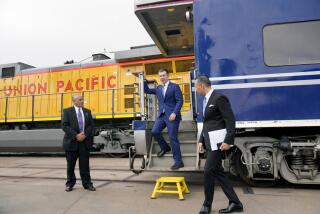N.Y. Mayor Plans $10-Billion Renewal
- Share via
NEW YORK — Mayor Michael R. Bloomberg on Thursday announced an ambitious $10.6-billion redevelopment plan of new neighborhoods, rail links to airports and a tax-free zone to attract businesses in Lower Manhattan -- the neighborhood where the World Trade Center once stood.
The area would be transformed by parks, a promenade lined with 700 trees in the style of the Champs Elysees and schools and cultural institutions.
The mayor’s proposal came a week before the Lower Manhattan Development Corp. is expected to present seven competing proposals for the future of the trade center site itself.
“But no matter how magnificent the best design for the 16 acres of the World Trade Center site proves to be,” Bloomberg said, “it must be complemented by an equally bold vision for all of Lower Manhattan.”
Appearing before a gathering of business leaders, he added:
“We must reinvent Lower Manhattan.... If you study New York history, you realize that it is often at the moments when New York has faced its greatest challenges that we’ve had our greatest achievements.”
Reaction to the mayor’s proposal from local politicians and community groups generally was favorable.
Alan Gerson, chairman of the City Council’s Select Committee on the Redevelopment of Lower Manhattan, called the plan “an excellent partial vision” but warned, “the devil is in the details.”
One of the biggest details is finding financing when the city faces its most serious budget gaps in decades, a fact Bloomberg noted in his speech to a meeting of the Assn. for a Better New York.
“Some will just feel scared, which is natural, and they might ask how we can afford to do this at this point in the city’s history,” the mayor said.
Bloomberg offered a menu of financing mechanisms, including $5.9 billion in federal funds already received for rebuilding the twin towers site.
Other sources of revenue could be sales of tax-free Liberty Bonds to stimulate commercial construction, and a tax plan his administration has proposed to the federal government designed to lure foreign companies to move their headquarters to Lower Manhattan.
The mayor said the Port Authority of New York and New Jersey could provide funds, and the sale of real estate development rights over some transit facilities could help defray costs.
“We have cataloged the costs of every one of these improvements down to the last tree where possible,” Bloomberg said.
“We have underinvested in Lower Manhattan for decades,” the mayor added. “It’s been 70 years since we built a new transit line downtown.”
Bloomberg called for a commuter train station at the trade center site in addition to new subway and ferry facilities. He said a public market would transform shopping and help anchor housing in two new neighborhoods.
The mayor said large-scale performing arts centers would draw tourists, stimulate private investments and help redefine Lower Manhattan.
“In a city that never sleeps, much of Lower Manhattan goes to bed promptly at 6 o’clock,” Bloomberg said.
He said when the trade center was first built, it was heralded as a cure-all for Lower Manhattan. But its impact on the city “was not all positive.”
The mayor said the center’s “voracious appetite for tenants” weakened the entire downtown real estate market, and the shopping mall beneath the twin towers complex detracted from commerce on the streets.
More to Read
Sign up for Essential California
The most important California stories and recommendations in your inbox every morning.
You may occasionally receive promotional content from the Los Angeles Times.













